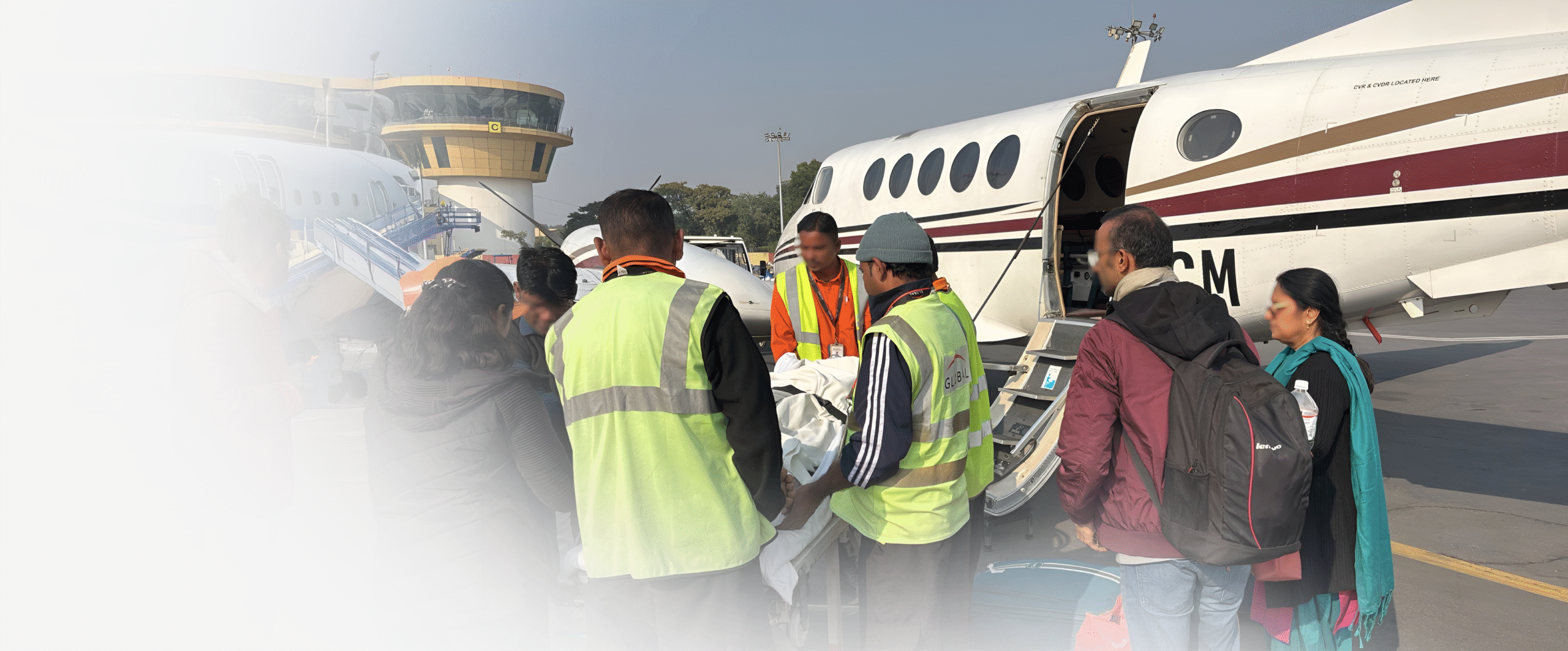What Is an Air Ambulance? 24/7 Air Ambulance Service in India
A life can hang by a thread while ordinary transport crawls through traffic, wasting precious minutes. An air ambulance transforms the very idea of emergency care. It is a mobile intensive care unit, a lifeline equipped with ventilators, cardiac monitors, and advanced medical instruments. Patients are never just passengers; they are continuously monitored, treated, and stabilized midair.
Unlike road ambulances, which are bound by traffic and geography, air ambulances bypass obstacles, soaring directly to specialized hospitals. They bring a level of care typically found only in hospital ICUs to the skies.
However, families always find it difficult to believe that such rapid response is truly accessible. The truth is that air ambulance services in India are designed to respond at any hour, equipped for critical interventions from neonatal emergencies to trauma cases. Every flight is a meticulous orchestration of aviation and medicine, combining trained personnel, life-support technology, and precise coordination with hospitals.
When You Need an Air Ambulance in India: Use Cases & Scenarios
Certain medical situations demand rapid response that road travel cannot provide. Air ambulances become indispensable in these time-sensitive scenarios.
Trauma and Accident Cases
Severe injuries from accidents require immediate transfer to trauma centers. Delays can worsen outcomes.
- Rapid response ensures stabilization en route
- Onboard ICU support manages critical complications
- Suitable for both urban and remote accident sites
Organ Transplants
Organs have limited viability. Quick transport is vital for saving lives.
- Swift transfer reduces ischemia time
- Specialized equipment maintains organ viability
- Medical escort ensures continuous monitoring
Inter-Hospital Transfers
Sometimes patients need advanced care unavailable at the current hospital.
- Seamless bed-to-bed transfers
- Reduces treatment delays
- Facilitates access to specialized procedures
International Repatriation
Patients abroad may require transfer to home-country hospitals for continuity of care.
- Coordination with foreign and domestic hospitals
- Expert handling of critical conditions during flights
- Ensures compliance with international medical standards
What’s Inside an Air Ambulance?
Air ambulances integrate advanced medical technology with aviation safety protocols to ensure patient stability and continuous care.
ICU-Level Equipment
Ventilators, infusion pumps, portable defibrillators, and cardiac monitors allow complex interventions mid-flight, addressing emergencies such as cardiac arrest, respiratory failure, or severe trauma.
Real-Time Monitoring and Telemedicine
Patient vitals are continuously monitored with telemetry systems, while telemedicine connects onboard staff with specialists for immediate consultation, ensuring evidence-based interventions.
Navigation and Safety Systems
GPS-based navigation and adherence to aviation safety standards ensure optimal routing, minimal delays, and compliance with international protocols.
How Does an Air Ambulance Work in Emergencies?
The air ambulance process is highly coordinated and systematic.
- Booking and Dispatch: Coordinators assess the patient’s condition and deploy the nearest available aircraft.
- Stabilization: On-ground medical teams stabilize the patient before takeoff.
- Onboard ICU Care: Critical monitoring and intervention continue throughout the journey.
- Hospital Coordination: Receiving hospitals are alerted to prepare for immediate treatment upon arrival.
How to Book an Air Ambulance in India
Booking an air ambulance involves a streamlined, step-by-step process:
- Contact the service and provide detailed patient information.
- Confirm aircraft availability and receive a transparent cost estimate.
- Stabilize the patient under medical guidance.
- Dispatch the aircraft and coordinate with the receiving hospital.
Red Air Ambulance ensures advantages of air ambulance include 24/7 availability, prompt communication, and expert guidance throughout the booking and transfer process, making life-saving transport accessible nationwide.
Air Ambulance Cost in India: Transparent Pricing and Reliable
Factors Affecting Air Ambulance Cost
Air ambulance charges in India vary based on multiple interrelated variables. Each element contributes to the final air ambulance service cost, reflecting the specialized care provided.
- Distance and Flight Duration: Longer routes increase fuel consumption, crew hours, and in-flight resources, making transfers costlier.
- Aircraft Type: Fully ICU-equipped chartered flights offer advanced care, while commercial stretcher flights are more economical but have limited facilities.
- Medical Team Specialization: Critical cases, neonatal transfers, and ECMO support require highly trained staff, which impacts pricing.
- Onboard Equipment and Support Systems: Ventilators, infusion pumps, cardiac monitors, and portable diagnostic tools are essential for continuous patient monitoring.
Transparency and Insurance Support
Transparent pricing ensures families receive a clear breakdown of air ambulance charges in India, avoiding unexpected costs. Leading providers, including Red Air Ambulance, offer insurance assistance, partially or fully covering expenses and allowing families to concentrate entirely on patient care.
Common Myths About Air Ambulance Services
Myth 1: Air Ambulances Are Excessively Expensive
While initial charges may appear high, air ambulances are cost-effective in emergencies. Time saved, continuous ICU-level care, and rapid hospital access often prevent complications, shorten recovery, and save lives.
Myth 2: Air Ambulances Are Unsafe
All flights comply with international aviation and medical standards. Continuous monitoring, pre-flight assessments, and skilled medical staff ensure the highest safety levels.
Myth 3: Air Ambulances Are Only for VIPs
Air ambulance services prioritize medical urgency over social status. Any patient requiring immediate intervention can access these services, whether in urban centers or remote areas.
Preparing a Patient for Air Ambulance Transfer – Checklist
Transferring a critically ill patient via air ambulance in India demands more than just boarding a flight. Every action before departure sets the stage for a safe, uninterrupted journey. Preparation becomes the silent guardian of patient survival, ensuring that care continues seamlessly from one facility to another.
Stabilize the Patient
Before wheels lift off the ground, the patient’s condition must be carefully balanced. Vital signs, breathing support, and emergency medications are meticulously managed. Even minor instability can escalate mid-flight, so ensuring optimal physiological balance is the first safeguard. Stabilization is not merely a step; it is a shield against unpredictable in-flight complications.
Organize Medical Documentation
Medical history transforms into a compass for the medical team in transit. Lab reports, imaging results, prescriptions, operative notes, and identification details must be compiled systematically. Every sheet, every record, tells a story of the patient’s condition, guiding life-saving decisions while allowing receiving hospitals to pick up the thread of care without hesitation.
Coordinate with Receiving Hospital
A transfer is only as effective as the destination is prepared. Sharing precise details about the patient’s condition, expected arrival time, and special requirements ensures the hospital stands ready. ICU beds, ventilators, and expert staff await, bridging the gap between in-flight care and hospital intervention. Coordination transforms urgency into a controlled, predictable process.
Pack Essential Medications and Personal Items
Medications are lifelines that cannot be interrupted. All necessary drugs, infusion sets, and emergency tools should travel alongside the patient. Personal items such as glasses, hearing aids, or even comfort items add a layer of psychological reassurance, reminding patients they are cared for holistically, not just medically.
Maintain Communication with the Air Ambulance Team
Information flows like oxygen between ground staff, family, and onboard medical personnel. Updates, clarifications, and last-minute instructions ensure everyone moves in unison. Communication acts as both guidance and reassurance, allowing the medical team to anticipate challenges and act decisively, keeping patient safety as the foremost priority.
Why Choose Red Air Ambulance Services?
Medical transfers are never routine. Each one carries a patient’s story, a family’s hopes, and the responsibility to bridge distance without losing safety. Red Air Ambulance approaches this responsibility with precision and empathy, ensuring that care doesn’t pause between hospitals.
Readiness Without Barriers
Availability isn’t about clocks or calendars, it’s about certainty. Our dispatch teams remain operational around the clock, so requests turn into action immediately, not eventually.
Care That Travels With You
An aircraft with advanced life-support equipment is only part of the solution. What matters most is the team that knows how to use it under pressure—doctors, nurses, and paramedics who treat the cabin as an extension of an ICU.
Technology Aligned to Need
From ventilators to defibrillators and real-time monitoring, every device is chosen not for display but for purpose: to stabilize, support, and sustain critical patients mid-flight.
Speed Matched by Structure
Fast response alone is not enough. What sets Red apart is structured planning—airport clearances, hospital coordination, and equipment setup are aligned before takeoff to reduce avoidable delays.
No Distance Too Far
Whether the transfer is within India or across continents, reach is never restricted. Our network ensures patients can access advanced treatment wherever it is available.
Pricing Without Uncertainty
Families deserve clarity, not hidden numbers. Red maintains transparent, upfront pricing so decisions can be made with confidence, not confusion.
Families Included, Not Overlooked
Communication is part of care. From the first call to the hospital handover, families are kept informed, reassured, and involved—because their peace of mind matters too.
Red Air Ambulance is not chosen only for its aircraft or speed in India but for its ability to make difficult journeys safe, organized, and humane.
FAQs
Q1. Why would you go in an air ambulance?
Ans: You would use an air ambulance when urgent medical transport is required over long distances. It ensures critically ill or injured patients reach specialized hospitals quickly, with continuous in-flight medical care and advanced life-support equipment available.
Q2. What does air ambulance mean?
Ans: An air ambulance is a specially equipped aircraft that functions like a flying ICU. It carries advanced medical equipment and trained professionals to safely transfer patients needing urgent, long-distance medical care, nationally or internationally, without interrupting treatment.
Q3. How far can an air ambulance fly?
Ans: Air ambulances can cover hundreds to thousands of kilometers, depending on aircraft type and patient needs. They are designed for intercity, interstate, and international transfers, ensuring critically ill patients reach advanced hospitals safely across long distances.
Does India have an air ambulance?
Ans: Yes, India has dedicated air ambulance services available across major cities and regions. These aircraft provide critical care during transfers, supporting both domestic and international patient movement to ensure timely access to advanced medical treatment facilities.
What is the cost of an air ambulance in India?
Ans: The cost of an air ambulance in India varies based on distance, aircraft type, and medical equipment needed. Usually, charges range from a few lakh rupees domestically to significantly higher for international transfers.


 18001207004
18001207004
 September 9, 2025
September 9, 2025 Red Health
Red Health